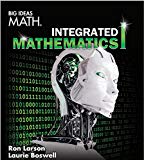
Concept explainers
To write if-then form, the converse, the inverse, the contrapositive, and the biconditional of the given conditional statement.
Answer to Problem 10CT
If-then form conditional statement:
If relation is a function then each input has exactly one output.
The converse of a conditional statement:
If each input has exactly one output then relation is a function
The inverse conditional statement:
If relation is not a function then each input does not have exactly one output.
The contrapositive conditional statement:
If each input does not have exactly one output then relation is not a function.
The biconditional of the conditional statement:
Relation is a function if and only if each input has exactly one output.
Explanation of Solution
Given information:
The conditional statement given is
A relation that pairs each input with exactly one output is a function
Concept used:
If-then form conditional statement:
When a conditional statement is written if-then form the “if” part contains the hypothesis and the “then” part contains the conclusion.
The converse of a conditional statement:
To write the converse of a conditional statement, exchange the hypothesis and the conclusion.
The inverse conditional statement:
To write the inverse of a conditional statement, negate both the hypothesis and the conclusion.
The contrapositive conditional statement:
To write the contrapositive of a conditional statement, first write the converse. Then negate both the hypothesis and the conclusion.
The biconditional of the conditional statement:
When a conditional statement and its converse both are true, it can be written as a single statement using phrase “if and only if” it is called biconditional statement.
If-then form conditional statement:
If relation is a function then each input has exactly one output.
The converse of a conditional statement:
If each input has exactly one output then relation is a function
The inverse conditional statement:
If relation is not a function then each input does not have exactly one output.
The contrapositive conditional statement:
If each input does not have exactly one output then relation is not a function.
The biconditional of the conditional statement:
Relation is a function if and only if each input has exactly one output.
Chapter 9 Solutions
BIG IDEAS MATH Integrated Math 1: Student Edition 2016
- Prove by induction that for any natural number N, 1 N Σ42 = 6 N(N + 1)(2N + 1). k=1 Indicate clearly where you use the inductive hypothesis.arrow_forward2x-y=1 x+2y=7 y = 2x + 2 3x + 2y = 4 x+3y=0 x-3y=6 8 4x-2y=7 x + 3y = 7 10 2x-2y=5 2x + 3y+ 1 = 0 Ke int lin Chapter 14arrow_forward(a) (b) Let A, B be disjoint subsets of a set X. Show that AC Bc. Use proof by contradiction to show that for any a, b = R, if a is rational and b is irrational then ba is irrational.arrow_forward
- (d) Consider the sequences (xn), (yn) defined recursively as follows: Xn+1 = xn2yn, i. ii. n, Yn+1=Yn2xn for n ≥ 1, x1 = 1, y₁ = 2. Calculate x2, y2 and x3, Y3. - Show using induction or otherwise that for any natural number - Xn+Yni = (1+2i)". Hence or otherwise, show that for any natural number n, iii. Zn = (V5)” cos(n arctan2), n = (V5)” sin(n arctan 2).arrow_forward2. (a) For each of the following functions, decide whether it is injective, and whether it is surjective. Justify your answers. i. f: Z → 22 Z 3z +1 ii. 9: C→ 22 Re(z) + Im(z)arrow_forwardNot use ai pleasearrow_forward
- 2. Given f(0) = (2 cos 0)² - 3sin²0. 1 a. Show that f(0) = ½ + ½ 7 + - cos cos 20. 2 2 b. Hence, find the exact value of √² 0 ƒ (0) do.arrow_forward2. Given f(0) = (2 cos 0)² - 3sin²0. 1 a. Show that f(0) = ½ + ½ 7 +-cos cos 20. 2 2 b. Hence, find the exact value of √ ƒ (0) d0.arrow_forwardNot use ai pleasearrow_forward
- In a crossover trial comparing a new drug to a standard, π denotes the probabilitythat the new one is judged better. It is desired to estimate π and test H0 : π = 0.5against H1 : π = 0.5. In 20 independent observations, the new drug is better eachtime.(a) Find and plot the likelihood function. Give the ML estimate of π (Hint: youmay use the plot function in R)arrow_forwardQ9. If A and B are two events, prove that P(ANB) ≥ 1 − P(Ā) – P(B). [Note: This is a simplified version of the Bonferroni inequality.] -arrow_forwardCan you explain what this analysis means in layman's terms? - We calculated that a target sample size of 3626, which was based on anticipated baseline 90-day mortality of 22% and a noninferiority margin of no more than 4 percentage points, would give the trial 80% power, at a one-sided alpha level of 2.5%, accounting for a maximum of 5% loss to follow-up and for early stopping rules for three interim analyses.-arrow_forward
 Discrete Mathematics and Its Applications ( 8th I...MathISBN:9781259676512Author:Kenneth H RosenPublisher:McGraw-Hill Education
Discrete Mathematics and Its Applications ( 8th I...MathISBN:9781259676512Author:Kenneth H RosenPublisher:McGraw-Hill Education Mathematics for Elementary Teachers with Activiti...MathISBN:9780134392790Author:Beckmann, SybillaPublisher:PEARSON
Mathematics for Elementary Teachers with Activiti...MathISBN:9780134392790Author:Beckmann, SybillaPublisher:PEARSON
 Thinking Mathematically (7th Edition)MathISBN:9780134683713Author:Robert F. BlitzerPublisher:PEARSON
Thinking Mathematically (7th Edition)MathISBN:9780134683713Author:Robert F. BlitzerPublisher:PEARSON Discrete Mathematics With ApplicationsMathISBN:9781337694193Author:EPP, Susanna S.Publisher:Cengage Learning,
Discrete Mathematics With ApplicationsMathISBN:9781337694193Author:EPP, Susanna S.Publisher:Cengage Learning, Pathways To Math Literacy (looseleaf)MathISBN:9781259985607Author:David Sobecki Professor, Brian A. MercerPublisher:McGraw-Hill Education
Pathways To Math Literacy (looseleaf)MathISBN:9781259985607Author:David Sobecki Professor, Brian A. MercerPublisher:McGraw-Hill Education





